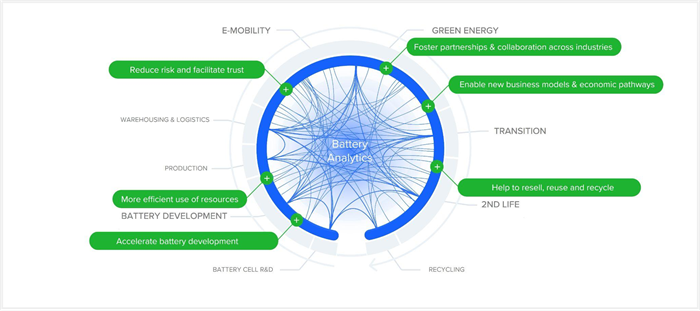
It is estimated that in 2021, there were approximately 25GWh of stationary battery installations worldwide. Considering that battery storage technologies are ideally equipped to handle the <challenges of the energy transition>, this figure will continue to rise over the coming years. With the deployment of energy storage gathering pace, and the cost & time to implementation decreasing, lithium-ion batteries can provide a significant chunk of the required flexibility. This is due to their high energy and power density for relatively low cost per unit of energy. Their response is very flexible allowing them to react in milliseconds or over a period of hours depending on the grid function required.
The power of battery analytics
Only a few short years ago, Utility scale battery systems were typically optimised for a single specific grid function e.g. frequency regulation, but over the last few years these demands have become increasingly more complex. Multi-use strategies, or a change of operating function after a period of time, have become mandatory to maximise profitability on sites.
However, to ensure profitability over the full lifetime, the Battery Energy Storage System needs to be managed effectively. Battery analytics can help users make the right decisions by providing insights and intelligence which otherwise may remain hidden in the copious amounts of data generated from a grid site.
As a result, sizing the system at initial deployment has become less important but requires new and deeper insights into the capabilities of the battery and how it operates during different operating strategies.
Battery analytics and complex smart learning algorithms enables flexibility to be exercised in the design and warranty and allows for customer friendly contracting conditions to be employed.

What are battery analytics for energy storage systems?
The World Economic Forum says, "Battery analytics provides data about the state of health and the remaining useful lifetime of a battery in a storage system." Once operational, it is critical to monitor and store performance data in real-time to assess current performance, safety trends and predict battery life longevity. Each battery system is typically controlled by an independent Energy Management System (EMS). This mandates how the battery will charge and discharge to the grid. The EMS typically uses data from the battery system to ensure that voltage, current & temperature amongst other crucial parameters are controlled during operation. This ensures the battery is maintained in optimal condition for maximum revenue potential, while the Battery Management System (BMS) keeps it in a safe condition at all times.
Knowledge is power, data is King.
Whilst battery analytics are a relatively recent addition, they are increasingly recognised as the key to more market traction and higher profitability. The available packages are continually and consistently evolving to keep up with the increasingly complexity of all relevant site data. The analytics software must be able to intelligently predict issues and schedule predictive maintenance (instead of reactive or preventative) which ultimately increases reliability, lowers running costs and maximises longevity of the battery.
This is realised by sensors feeding critical parameters back to the system for analysis and comparison against real world models. The analytical software then suggests corrections and adjustments to the usage profile of the battery in order to keep it on the correct course. This enables greater transparency into the projects for which ongoing warranty obligations are a major factor or to tune the service offering to differentiate from competition.
Example of how battery analytics interconnects with technology:

Battery analytics is the data-driven analysis of the state of health and remaining useful lifetime of a battery. ©TWAICE
Why battery analytics are critical in storage systems?
Ultimately, battery analytics enable us to "really know" the entire battery system.
Knowing the reasons why Battery Analytics are so critical in storage systems will help make valuable decisions easier and ensure that decisions are data driven, rather than being driven by perception.
There are of course a multitude of reasons why analytics are critical in energy storage but here are a few of the top ones.
Battery analytics allow "predictive", not preventative maintenance
Before the development of the latest battery analytics software, it was effectively a matter of trial and error to determine the optimal time for maintenance teams to conduct their work. Downtime on these sites can be very expensive, especially for unnecessary work to be carried out. Therefore, a battery systems bankability is greatly enhanced by the ability to accurately schedule maintenance work when it will cause least disruption to the site or its revenue generation. Today battery analytics allow managers to schedule and conduct "predictive maintenance" rather than expensive labour intensive, preventative guesswork maintenance.
Battery analytics optimize operation
Optimization of the battery itself, is one of the best ways to enhance the performance of the battery system and battery analytics allow the manager to do exactly that.
As the key component of any battery based system, optimising the battery cell is critical to maximising profit from generated revenues and realising optimal ROI's.
Battery analytics enable battery intelligence
Data from different systems at any location globally can be monitored in real-time and can be merged using analytic algorithms to detect trends from a cloud based or land based secure platform. This allows maintenance teams in charge of the storage systems to track health and performance of their asset more easily and from any location worldwide. Any potential risk to maintenance personnel is also minimised by detecting anomalies and enabling early warnings.
Battery analytics remove the guesswork
Having advanced data analytics in a visual and dynamic dashboard, provides intelligence to the user which simply wasn’t possible before analytics became mainstream. Battery analytics helps remove the guesswork from managing a system by being alerted to any unforeseen abnormal or unexpected battery performance. Analytics over time, enable informed decisions to be made.
Battery analytics enable warranty tracking
Battery analytics use actual data from the system being monitored to provide optimisation strategies to help prevent degradation and improve battery life.
Ultimately, the end goal is to accurately predict when and how the battery will reach its end-of-life. By knowing this, the user can actively plan for what happens next based on the battery system trending through time. This alone is a game-changer for the energy storage sector.
Trina Storage battery analytics
Why not give Trina Storage a call to discuss what our battery analytics can do for you?

– END –
